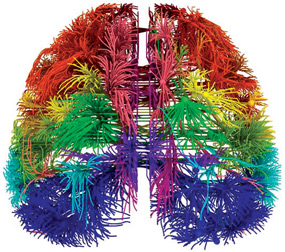Mysteries of the human brain revealed
Scientists release
detailed 3D image of its genes and pathways
Scientists have generated the first detailed pictures of the
intricate events in the womb that result in the formation of the human
brain. The study could prove to be a decisive breakthrough in
understanding the many cognitive disorders thought to be triggered
before birth - from autism to schizophrenia.
The researchers believe that the findings could one day lead to a
"blueprint for building the human brain" based on knowing the precise
sequence of genes that are selectively switched on and off in different
parts of the embryonic organ during the critical stages of development
in the womb.
|

A top-down view of the connections between several distinct
cortical areas, visualised using Allen Institute software |
Researchers at the Allen Institute for Brain Science in Seattle,
analysed the brains of four human foetuses between 15 and 21 weeks to
build up the first atlas of the developing brain based on differences in
gene activities - a so-called "transcriptome".
The work is part of a much wider body of research aimed at a
fundamental understanding of the brain, which is often described as the
most complex structure in the known universe. Senior scientists believe
that these revolutionary new techniques for studying the brain could
transform our knowledge of how the brain works and so lead to radical
new forms of prevention or treatment for the many psychological and
developmental disorders that have so far defied medicine.
"This is the beginning. We want to understand the blueprint whereby
we build a brain and this is one step in that direction, where we can
begin to have a map of how genes are driving the process," said Ed Lein
of the Allen Institute, who led the study."Knowing where a gene is
expressed in the brain can provide powerful clues about what its role
is.
This gives a comprehensive view of which genes are on and off in
which specific nuclei and cell types while the brain is developing
during pregnancy," Dr Lein said.
"This means we have a blueprint for human development, an
understanding of the crucial pieces necessary for the brain to form in a
normal, healthy way, and a powerful way to investigate what goes wrong
in disease," he said.
The study married neuroscience with the knowledge of the human genome
to produce highly detailed snapshots of gene activity at critical points
in development.
Each transcriptome changes over time as the brain develops, revealing
the varying gene activity and nerve connections that are formed and
re-formed as the human brain grows and develops in the womb between 15
and 21 weeks. "This is the time when we're beginning to establish the
neocortex of the brain, which is responsible for many of our most
distinctive cognitive features," Dr Lein said.
Autism could be the first developmental disorder to benefit from this
kind of approach to building up images of the developing brain - known
as the BrainSpan Atlas.
The research has already led to one potential insight into the
childhood disorder, he said. "We used the maps we created to find a hub
of genetic action that could be linked to autism, and we found one.
These genes were associated with the newly generated excitatory neurons
in the cortex, the area of the brain that is responsible for many of the
cognitive features affected in autism such as social behaviour," Dr Lein
said.
- The Independent
|

